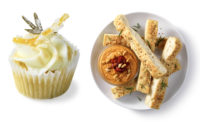Interest in “slower” food and deeper connections to food sources has brought heirloom tomatoes, heritage breeds of livestock, and ancient and heirloom grains to the fore.
Bakers and consumers are increasingly interested in older, heritage ingredients because they are considered to be cleaner, simpler and have interesting stories and origins behind them. Chefs and consumers are becoming more familiar with using wheat and grain berries, not just for flour, but in grain bowls and other dishes. The popularity of Danish and Swedish cuisines has brought more interest in rye berries and barley, which in turn brings more interest in using these flours.
Different heirloom grains open up the flavors and stories of different bread styles around the world. Rye flour, one of the oldest grains common to Nordic countries, is milled from whole rye berries and is closely related to wheat flour. It has its own distinct flavor and is slightly darker than traditional wheat, depending on how much of the bran stays intact.
The darkest rye, with the most bran left intact, is used in Boston brown bread and pumpernickel, while light rye is widely used in Swedish flatbreads. More bakers are experimenting with rye and breaking away from the familiar application of Jewish rye with caraway seeds.
For bakers who are interested in learning more about different wheats and grains, I recommend getting your hands on whatever you can and treating the whole grains as you would any comparison tasting, like coffee, nuts or olive oil. Note the different aromas, colors and textures of grains like emmer, Turkey Red, Red Fife, White Sonora and Khorasan wheats as you experiment with these ingredients in your baking.
Once bakers become more comfortable working with heirloom grains and flours, some try 100 percent replacement with these varieties. For others, employ a combination of several heirloom flours to create various flavorful breads. Using a combination of different types of flour—for example 20 percent spelt, 10 percent Einkorn and the rest traditional wheat flour—creates subtle differences in flavor, color and texture. Combining and mixing is a great way to experiment with different flours based on personal taste, desired texture and availability.
When considering products for commercialization, bakers should take supply-chain dynamics for heirloom wheat and ancient grains into account. For larger-scale baking, spelt and rye are heirloom varieties that are more widely available. They also have similar functionality to modern wheat, so bakers can use them in a variety of styles. Red Fife and White Sonora can be harder to source on a consistent basis, but as more small-scale bakers use these varieties, we expect demand and supplies to increase.
Pro tips for innovating with heirlooms:
- Head to class: Many industry organizations, such as The Bread Bakers Guild of America, offer classes or conferences on specialty grains.
- Easy value-adds: Try replacing 10 or 20 percent traditional white flour with a heritage wheat like Red Fife, rye or spelt.
- Check your fluids: Many heirloom wheats take up a lot of moisture; experiment with added liquid levels as you mix.
- Adjust loaf sizes: Traditional, slow-crafted breads with premium heirloom wheats are more expensive; smaller loaves allow more people to try these breads at an approachable price point.
No matter what the size of your operation, heirloom wheat—used even in small amounts—can add innovative flavors, colors, textures and the allure of tradition to your work.






